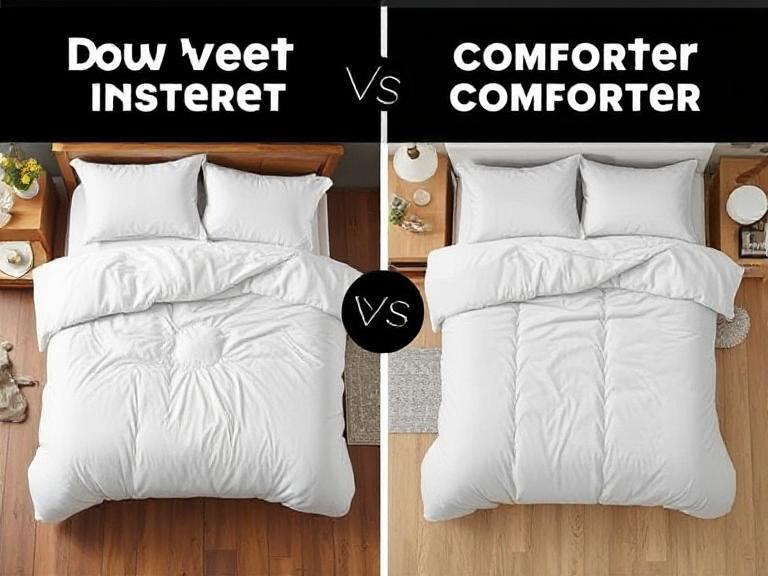
Duvet Insert vs Comforter: Which Is Right for Your Bed in 2025?
Share
Table of Contents Duvet Insert vs Comforter
- Introduction
- Defining Duvet Insert and Comforter
- Key Differences
- Benefits of Each Option
- When to Choose a Duvet Insert vs a Comforter
- Wildnace Bedding Supply & Your Bedding Needs
- Care & Maintenance
- Conclusion
- Summary Table
- References
Introduction Duvet Insert vs Comforter
Choosing between a duvet insert and a comforter is a common question when updating your bedding. Both provide warmth and style, but they function differently. In this guide, we’ll break down their designs, benefits, cleaning needs, and help you determine the best option based on lifestyle and preferences.

Defining Duvet Insert and Comforter
Duvet Insert
A duvet insert is a thick, fluffy bag filled with down, feathers, synthetic fibers, or alternatives. It is designed to go inside a removable duvet cover that protects it and allows style customization .
Comforter
A comforter is a single-piece quilted bedding item with fabric shells permanently stitched around the fill. It is styled and used as-is, with no separate cover typically required .
Key Differences
- Structure: Duvet insert + cover (two parts) vs. comforter (single piece) .
- Customization: Duvets are highly customizable via covers; comforters have fixed appearance.
- Cleaning: Duvet covers are washable frequently; inserts less so. Comforters need washing entirely .
- Weight & Warmth: Duvets often fluffier and warmer; comforters flatter and suitable for moderate climates .
- Maintenance: Inserts may shift inside covers unless corner ties are used; comforters stay in place better.
Benefits of Each Option
Benefits of a Duvet Insert
- Style Flexibility: Change your bedroom look by swapping covers .
- Easier Maintenance: Wash covers frequently instead of the bulky insert .
- Seasonal Swap: Switch to lighter or heavier inserts as needed .
Benefits of a Comforter
- Simplicity: Ready to use without extra components.
- Lower Cost: Typically more affordable as a single item.
- Stays Put: Doesn’t shift like an insert might inside a cover .
When to Choose a Duvet Insert vs a Comforter
- Go with a duvet insert if: you value customization, easy laundering, and seasonal flexibility.
- Choose a comforter if: you prefer convenience, single-piece styling, and affordability.
- If you enjoy changing décor or want a cleaner routine, duvets provide versatility. For hassle-free bedding, comforters win.
Wildnace Bedding Supply & Your Bedding Needs

Wildnace prioritizes ethical sourcing, sustainability, and premium comfort in all products. Whether you prefer a duvet set or a comforter-style bedding solution, Wildnace offers:
- Duvet sets including duvet covers and inserts
- Sheet sets and separates for various styles
- Pillowcases for matching bedding aesthetics
With Wildnace, you can enjoy the flexibility of swapping covers or opt for a stylish integrated comforter alternative—all made with eco-conscious materials and thoughtful design.
Care & Maintenance
Duvet Insert + Cover
- Wash covers every 1–2 weeks; wash the insert every few months or as needed .
- Use duvet clips or corner loops to prevent shifting.
Comforter
- Machine-washable models available; heavier versions may require professional cleaning.
- Avoid frequent washing to preserve loft and fill integrity.
Conclusion
In summary, a duvet insert offers unmatched customization, easy maintenance, and seasonal adaptability, while a comforter delivers simplicity, affordability, and convenience. If you love changing your bedroom’s look or want easier washing, duvet sets from Wildnace are an excellent option. If you prefer all‑in‑one bedding with minimal fuss, a comforter may be more suitable.
Summary Table
| Factor | Duvet Insert + Cover | Comforter |
|---|---|---|
| Structure | Insert + removable cover | All-in-one quilted cover + fill |
| Style Flexibility | High (swap covers easily) | Low (fixed look) |
| Cleaning | Cover frequently washable; insert less | Requires washing entire unit |
| Warmth & Loft | Typically more plush and customizable | Moderate insulation, flatter profile |
| Cost | Higher upfront (insert + cover) | Lower cost, single product |
| Best For | Style-conscious, seasonal changes | Convenience, minimal upkeep |
